Obligations under WHS Act 2011: Leadership and Management Perspective
VerifiedAdded on 2023/01/13
|6
|1565
|31
Homework Assignment
AI Summary
This assignment examines the Work Health and Safety Act 2011 (WHS) in Queensland, Australia, focusing on the responsibilities of employees, supervisors, and managers. It outlines the obligations related to equipment usage, maintenance, and overall workplace safety. The assignment details how a manager would implement WHS policies, including written information, oral briefings, and periodic reviews. It explores various WHS information systems, such as management and decision support systems. The hierarchy of control for risk management is explained, along with other relevant regulations like the Work Health and Safety Regulation 2011 and the Safe Work Australia code of practice. The role of a WHS committee is discussed, along with the importance of training for health and safety representatives. The assignment also covers occupational hazard management, the process of incident reporting, and the creation of fire safety procedures. Finally, it emphasizes the importance of staying updated with changing WHS regulations and the ongoing nature of risk management.
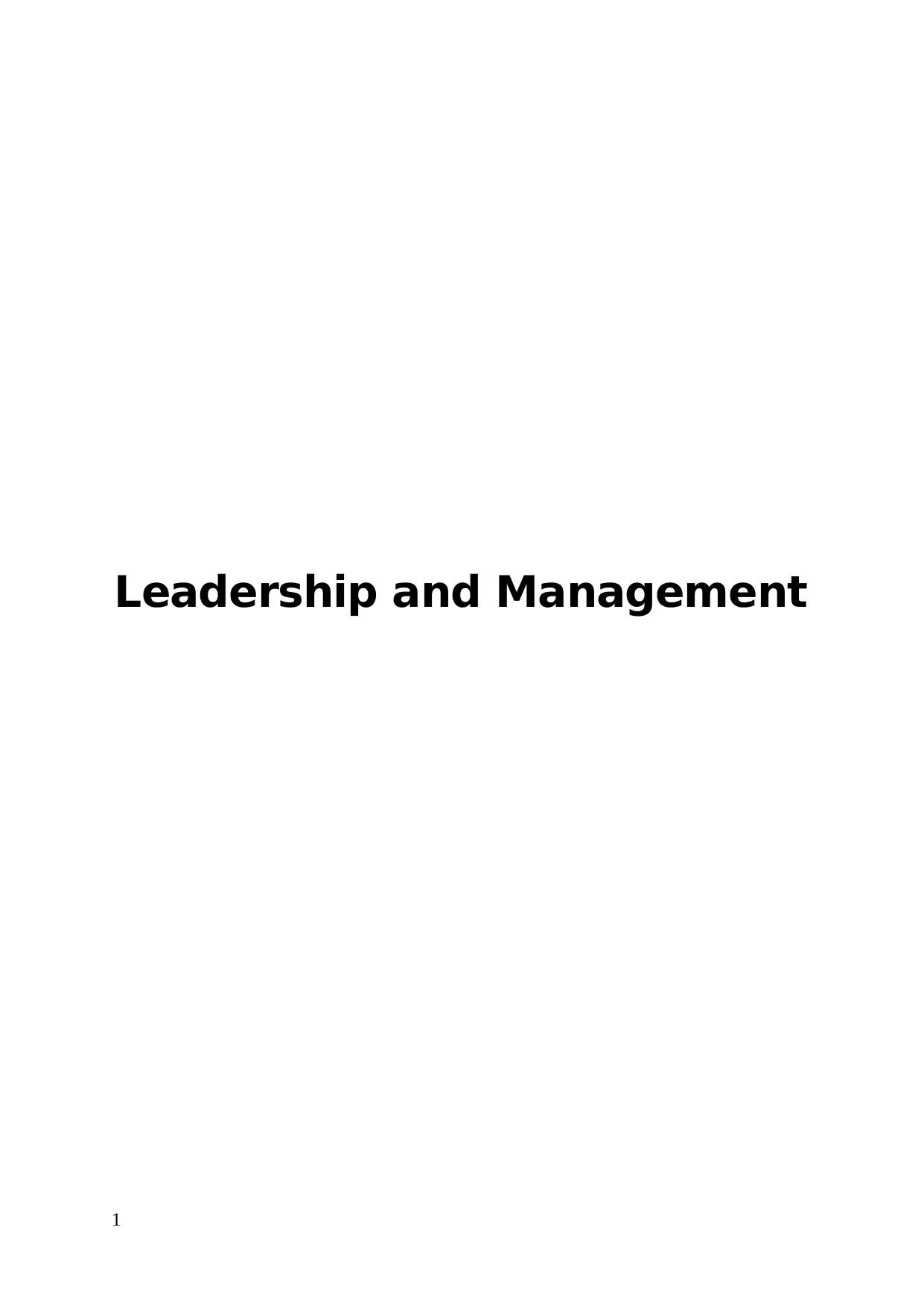
Leadership and Management
1
1
Paraphrase This Document
Need a fresh take? Get an instant paraphrase of this document with our AI Paraphraser
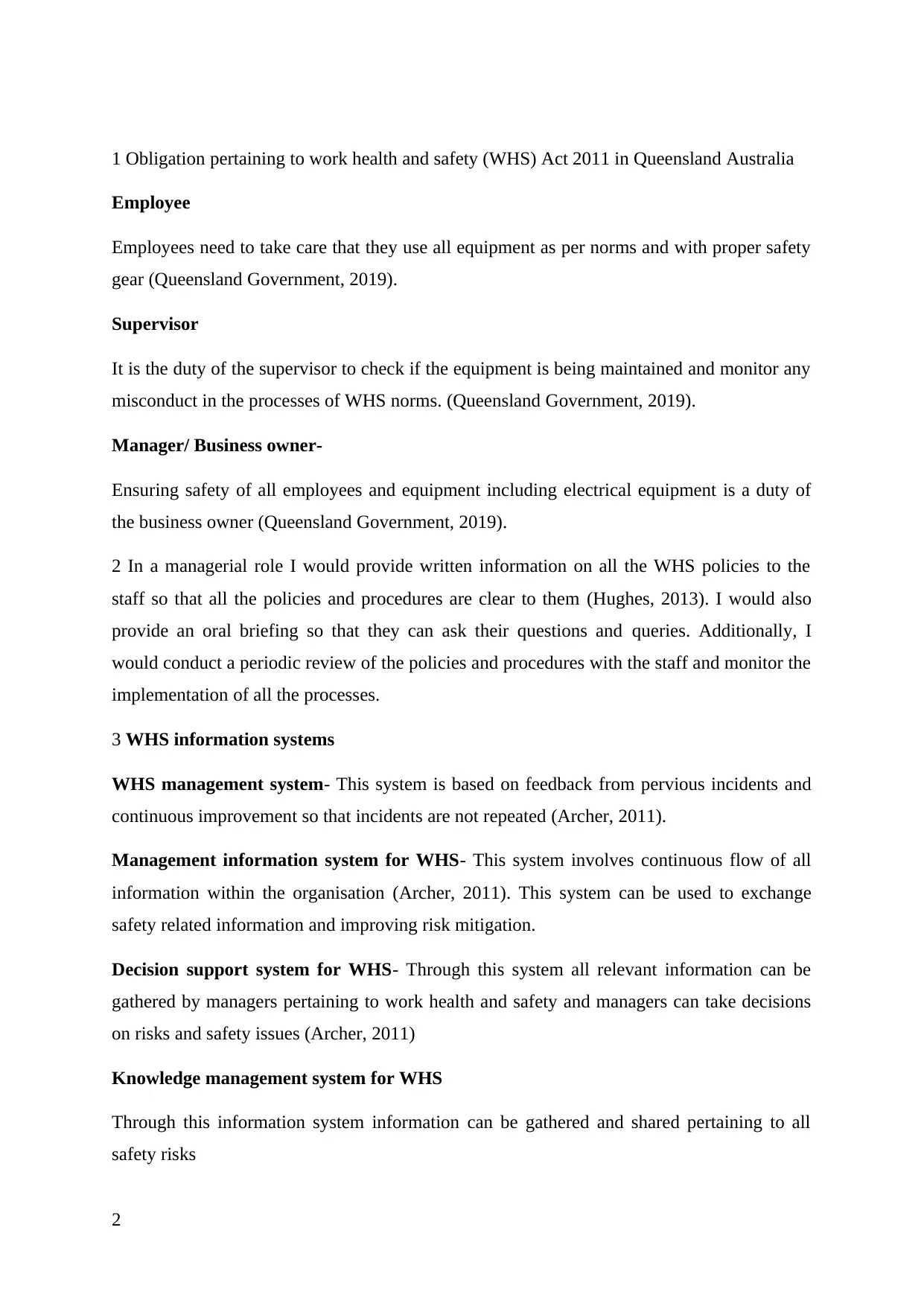
1 Obligation pertaining to work health and safety (WHS) Act 2011 in Queensland Australia
Employee
Employees need to take care that they use all equipment as per norms and with proper safety
gear (Queensland Government, 2019).
Supervisor
It is the duty of the supervisor to check if the equipment is being maintained and monitor any
misconduct in the processes of WHS norms. (Queensland Government, 2019).
Manager/ Business owner-
Ensuring safety of all employees and equipment including electrical equipment is a duty of
the business owner (Queensland Government, 2019).
2 In a managerial role I would provide written information on all the WHS policies to the
staff so that all the policies and procedures are clear to them (Hughes, 2013). I would also
provide an oral briefing so that they can ask their questions and queries. Additionally, I
would conduct a periodic review of the policies and procedures with the staff and monitor the
implementation of all the processes.
3 WHS information systems
WHS management system- This system is based on feedback from pervious incidents and
continuous improvement so that incidents are not repeated (Archer, 2011).
Management information system for WHS- This system involves continuous flow of all
information within the organisation (Archer, 2011). This system can be used to exchange
safety related information and improving risk mitigation.
Decision support system for WHS- Through this system all relevant information can be
gathered by managers pertaining to work health and safety and managers can take decisions
on risks and safety issues (Archer, 2011)
Knowledge management system for WHS
Through this information system information can be gathered and shared pertaining to all
safety risks
2
Employee
Employees need to take care that they use all equipment as per norms and with proper safety
gear (Queensland Government, 2019).
Supervisor
It is the duty of the supervisor to check if the equipment is being maintained and monitor any
misconduct in the processes of WHS norms. (Queensland Government, 2019).
Manager/ Business owner-
Ensuring safety of all employees and equipment including electrical equipment is a duty of
the business owner (Queensland Government, 2019).
2 In a managerial role I would provide written information on all the WHS policies to the
staff so that all the policies and procedures are clear to them (Hughes, 2013). I would also
provide an oral briefing so that they can ask their questions and queries. Additionally, I
would conduct a periodic review of the policies and procedures with the staff and monitor the
implementation of all the processes.
3 WHS information systems
WHS management system- This system is based on feedback from pervious incidents and
continuous improvement so that incidents are not repeated (Archer, 2011).
Management information system for WHS- This system involves continuous flow of all
information within the organisation (Archer, 2011). This system can be used to exchange
safety related information and improving risk mitigation.
Decision support system for WHS- Through this system all relevant information can be
gathered by managers pertaining to work health and safety and managers can take decisions
on risks and safety issues (Archer, 2011)
Knowledge management system for WHS
Through this information system information can be gathered and shared pertaining to all
safety risks
2
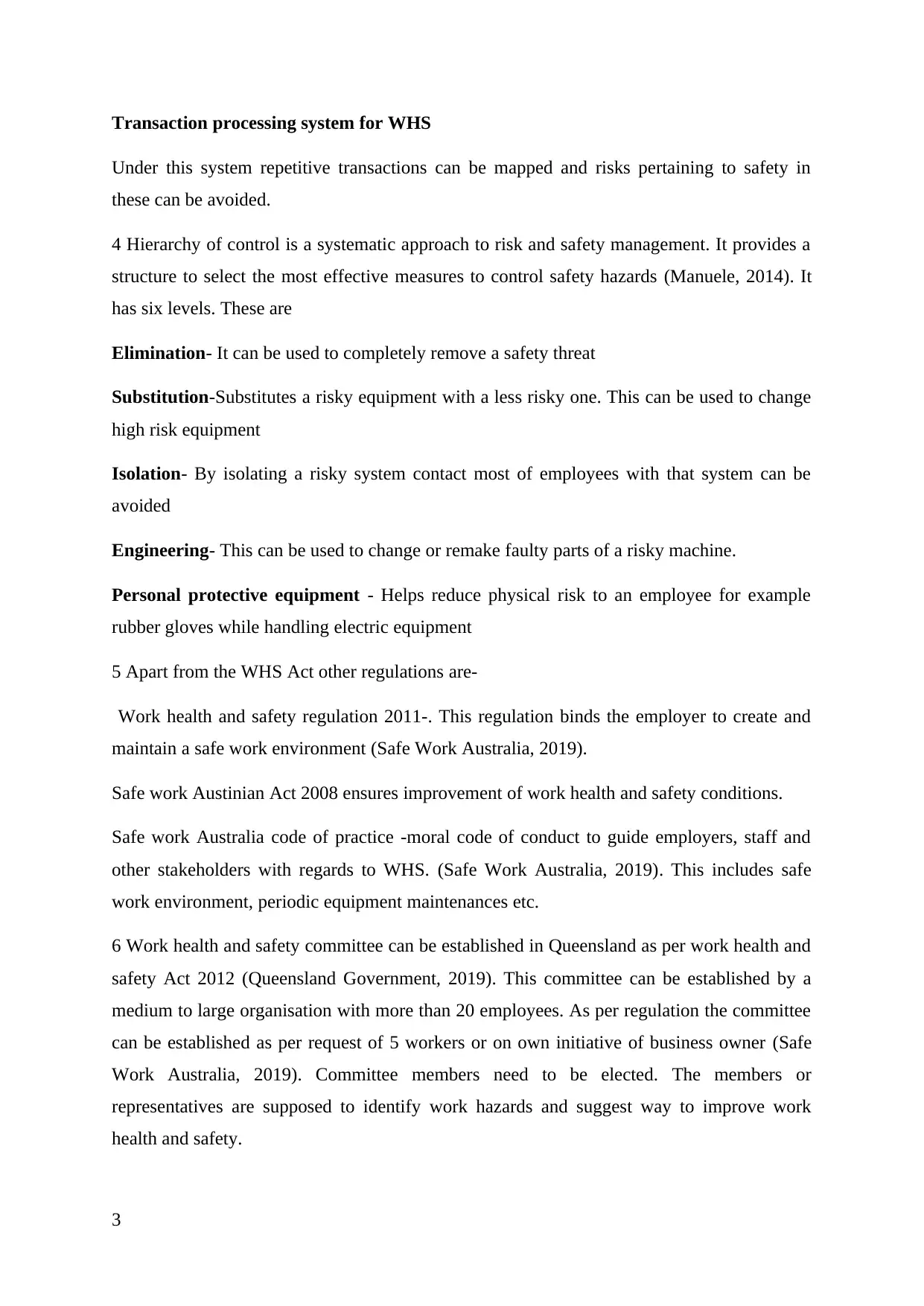
Transaction processing system for WHS
Under this system repetitive transactions can be mapped and risks pertaining to safety in
these can be avoided.
4 Hierarchy of control is a systematic approach to risk and safety management. It provides a
structure to select the most effective measures to control safety hazards (Manuele, 2014). It
has six levels. These are
Elimination- It can be used to completely remove a safety threat
Substitution-Substitutes a risky equipment with a less risky one. This can be used to change
high risk equipment
Isolation- By isolating a risky system contact most of employees with that system can be
avoided
Engineering- This can be used to change or remake faulty parts of a risky machine.
Personal protective equipment - Helps reduce physical risk to an employee for example
rubber gloves while handling electric equipment
5 Apart from the WHS Act other regulations are-
Work health and safety regulation 2011-. This regulation binds the employer to create and
maintain a safe work environment (Safe Work Australia, 2019).
Safe work Austinian Act 2008 ensures improvement of work health and safety conditions.
Safe work Australia code of practice -moral code of conduct to guide employers, staff and
other stakeholders with regards to WHS. (Safe Work Australia, 2019). This includes safe
work environment, periodic equipment maintenances etc.
6 Work health and safety committee can be established in Queensland as per work health and
safety Act 2012 (Queensland Government, 2019). This committee can be established by a
medium to large organisation with more than 20 employees. As per regulation the committee
can be established as per request of 5 workers or on own initiative of business owner (Safe
Work Australia, 2019). Committee members need to be elected. The members or
representatives are supposed to identify work hazards and suggest way to improve work
health and safety.
3
Under this system repetitive transactions can be mapped and risks pertaining to safety in
these can be avoided.
4 Hierarchy of control is a systematic approach to risk and safety management. It provides a
structure to select the most effective measures to control safety hazards (Manuele, 2014). It
has six levels. These are
Elimination- It can be used to completely remove a safety threat
Substitution-Substitutes a risky equipment with a less risky one. This can be used to change
high risk equipment
Isolation- By isolating a risky system contact most of employees with that system can be
avoided
Engineering- This can be used to change or remake faulty parts of a risky machine.
Personal protective equipment - Helps reduce physical risk to an employee for example
rubber gloves while handling electric equipment
5 Apart from the WHS Act other regulations are-
Work health and safety regulation 2011-. This regulation binds the employer to create and
maintain a safe work environment (Safe Work Australia, 2019).
Safe work Austinian Act 2008 ensures improvement of work health and safety conditions.
Safe work Australia code of practice -moral code of conduct to guide employers, staff and
other stakeholders with regards to WHS. (Safe Work Australia, 2019). This includes safe
work environment, periodic equipment maintenances etc.
6 Work health and safety committee can be established in Queensland as per work health and
safety Act 2012 (Queensland Government, 2019). This committee can be established by a
medium to large organisation with more than 20 employees. As per regulation the committee
can be established as per request of 5 workers or on own initiative of business owner (Safe
Work Australia, 2019). Committee members need to be elected. The members or
representatives are supposed to identify work hazards and suggest way to improve work
health and safety.
3
⊘ This is a preview!⊘
Do you want full access?
Subscribe today to unlock all pages.

Trusted by 1+ million students worldwide
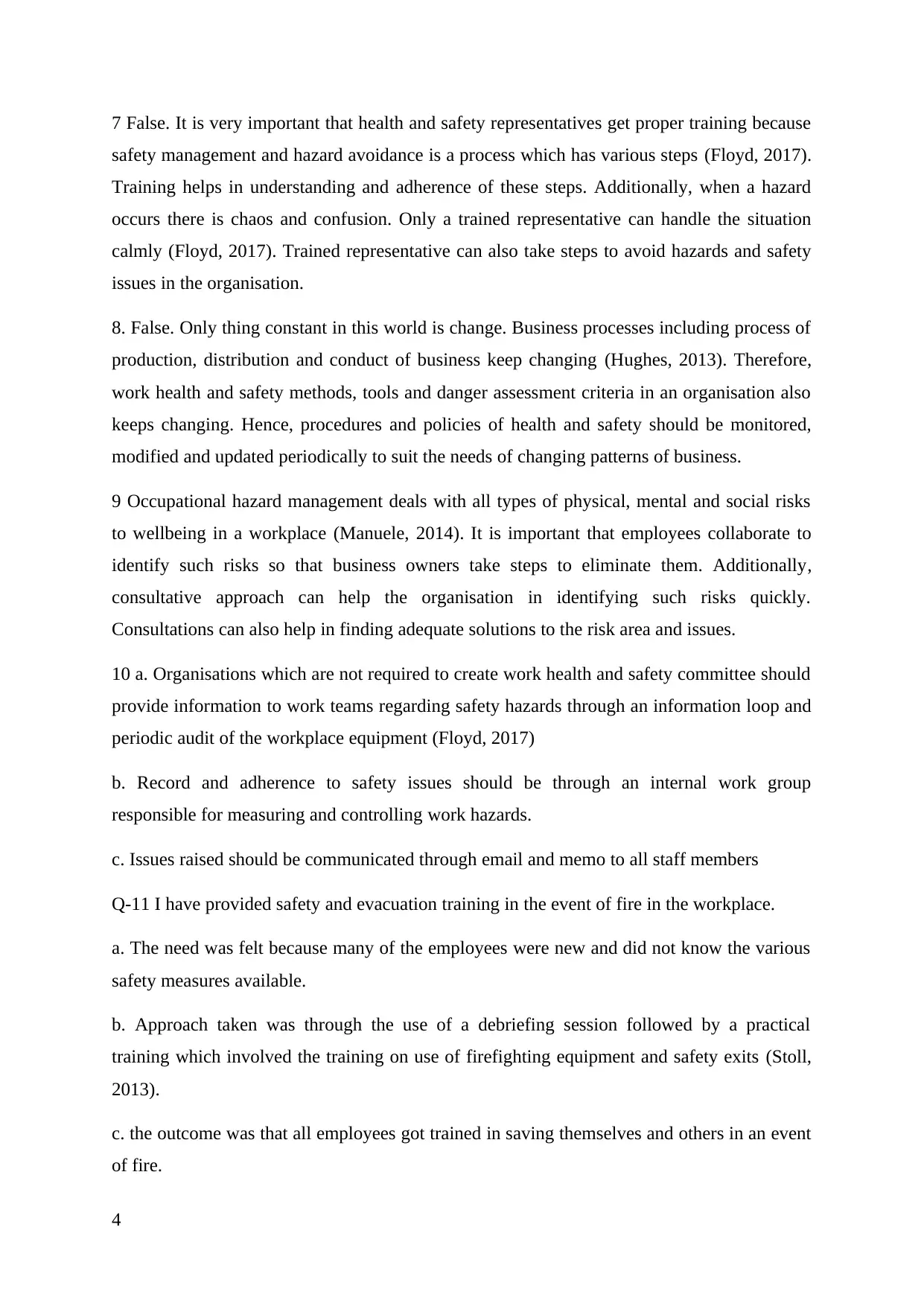
7 False. It is very important that health and safety representatives get proper training because
safety management and hazard avoidance is a process which has various steps (Floyd, 2017).
Training helps in understanding and adherence of these steps. Additionally, when a hazard
occurs there is chaos and confusion. Only a trained representative can handle the situation
calmly (Floyd, 2017). Trained representative can also take steps to avoid hazards and safety
issues in the organisation.
8. False. Only thing constant in this world is change. Business processes including process of
production, distribution and conduct of business keep changing (Hughes, 2013). Therefore,
work health and safety methods, tools and danger assessment criteria in an organisation also
keeps changing. Hence, procedures and policies of health and safety should be monitored,
modified and updated periodically to suit the needs of changing patterns of business.
9 Occupational hazard management deals with all types of physical, mental and social risks
to wellbeing in a workplace (Manuele, 2014). It is important that employees collaborate to
identify such risks so that business owners take steps to eliminate them. Additionally,
consultative approach can help the organisation in identifying such risks quickly.
Consultations can also help in finding adequate solutions to the risk area and issues.
10 a. Organisations which are not required to create work health and safety committee should
provide information to work teams regarding safety hazards through an information loop and
periodic audit of the workplace equipment (Floyd, 2017)
b. Record and adherence to safety issues should be through an internal work group
responsible for measuring and controlling work hazards.
c. Issues raised should be communicated through email and memo to all staff members
Q-11 I have provided safety and evacuation training in the event of fire in the workplace.
a. The need was felt because many of the employees were new and did not know the various
safety measures available.
b. Approach taken was through the use of a debriefing session followed by a practical
training which involved the training on use of firefighting equipment and safety exits (Stoll,
2013).
c. the outcome was that all employees got trained in saving themselves and others in an event
of fire.
4
safety management and hazard avoidance is a process which has various steps (Floyd, 2017).
Training helps in understanding and adherence of these steps. Additionally, when a hazard
occurs there is chaos and confusion. Only a trained representative can handle the situation
calmly (Floyd, 2017). Trained representative can also take steps to avoid hazards and safety
issues in the organisation.
8. False. Only thing constant in this world is change. Business processes including process of
production, distribution and conduct of business keep changing (Hughes, 2013). Therefore,
work health and safety methods, tools and danger assessment criteria in an organisation also
keeps changing. Hence, procedures and policies of health and safety should be monitored,
modified and updated periodically to suit the needs of changing patterns of business.
9 Occupational hazard management deals with all types of physical, mental and social risks
to wellbeing in a workplace (Manuele, 2014). It is important that employees collaborate to
identify such risks so that business owners take steps to eliminate them. Additionally,
consultative approach can help the organisation in identifying such risks quickly.
Consultations can also help in finding adequate solutions to the risk area and issues.
10 a. Organisations which are not required to create work health and safety committee should
provide information to work teams regarding safety hazards through an information loop and
periodic audit of the workplace equipment (Floyd, 2017)
b. Record and adherence to safety issues should be through an internal work group
responsible for measuring and controlling work hazards.
c. Issues raised should be communicated through email and memo to all staff members
Q-11 I have provided safety and evacuation training in the event of fire in the workplace.
a. The need was felt because many of the employees were new and did not know the various
safety measures available.
b. Approach taken was through the use of a debriefing session followed by a practical
training which involved the training on use of firefighting equipment and safety exits (Stoll,
2013).
c. the outcome was that all employees got trained in saving themselves and others in an event
of fire.
4
Paraphrase This Document
Need a fresh take? Get an instant paraphrase of this document with our AI Paraphraser
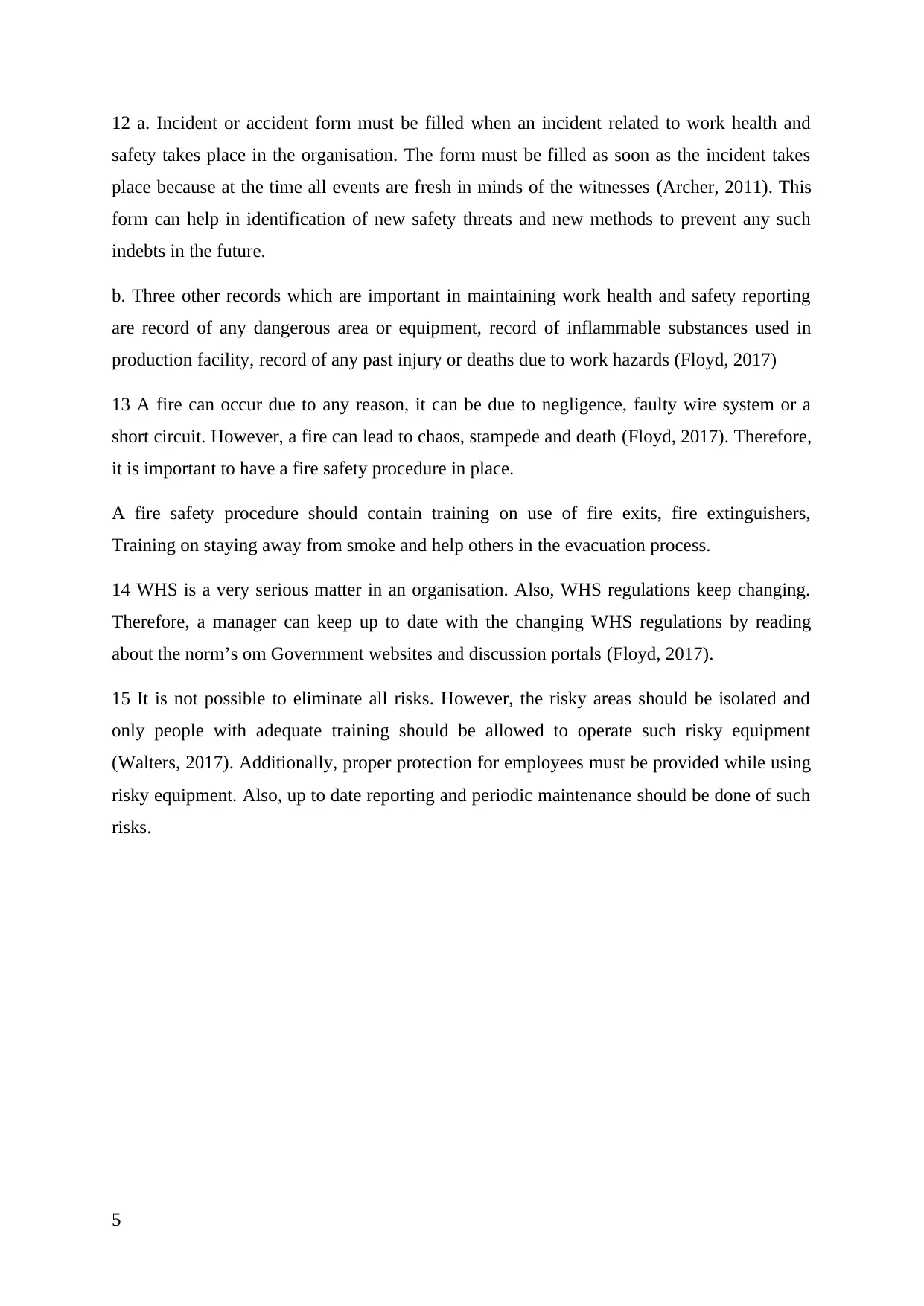
12 a. Incident or accident form must be filled when an incident related to work health and
safety takes place in the organisation. The form must be filled as soon as the incident takes
place because at the time all events are fresh in minds of the witnesses (Archer, 2011). This
form can help in identification of new safety threats and new methods to prevent any such
indebts in the future.
b. Three other records which are important in maintaining work health and safety reporting
are record of any dangerous area or equipment, record of inflammable substances used in
production facility, record of any past injury or deaths due to work hazards (Floyd, 2017)
13 A fire can occur due to any reason, it can be due to negligence, faulty wire system or a
short circuit. However, a fire can lead to chaos, stampede and death (Floyd, 2017). Therefore,
it is important to have a fire safety procedure in place.
A fire safety procedure should contain training on use of fire exits, fire extinguishers,
Training on staying away from smoke and help others in the evacuation process.
14 WHS is a very serious matter in an organisation. Also, WHS regulations keep changing.
Therefore, a manager can keep up to date with the changing WHS regulations by reading
about the norm’s om Government websites and discussion portals (Floyd, 2017).
15 It is not possible to eliminate all risks. However, the risky areas should be isolated and
only people with adequate training should be allowed to operate such risky equipment
(Walters, 2017). Additionally, proper protection for employees must be provided while using
risky equipment. Also, up to date reporting and periodic maintenance should be done of such
risks.
5
safety takes place in the organisation. The form must be filled as soon as the incident takes
place because at the time all events are fresh in minds of the witnesses (Archer, 2011). This
form can help in identification of new safety threats and new methods to prevent any such
indebts in the future.
b. Three other records which are important in maintaining work health and safety reporting
are record of any dangerous area or equipment, record of inflammable substances used in
production facility, record of any past injury or deaths due to work hazards (Floyd, 2017)
13 A fire can occur due to any reason, it can be due to negligence, faulty wire system or a
short circuit. However, a fire can lead to chaos, stampede and death (Floyd, 2017). Therefore,
it is important to have a fire safety procedure in place.
A fire safety procedure should contain training on use of fire exits, fire extinguishers,
Training on staying away from smoke and help others in the evacuation process.
14 WHS is a very serious matter in an organisation. Also, WHS regulations keep changing.
Therefore, a manager can keep up to date with the changing WHS regulations by reading
about the norm’s om Government websites and discussion portals (Floyd, 2017).
15 It is not possible to eliminate all risks. However, the risky areas should be isolated and
only people with adequate training should be allowed to operate such risky equipment
(Walters, 2017). Additionally, proper protection for employees must be provided while using
risky equipment. Also, up to date reporting and periodic maintenance should be done of such
risks.
5
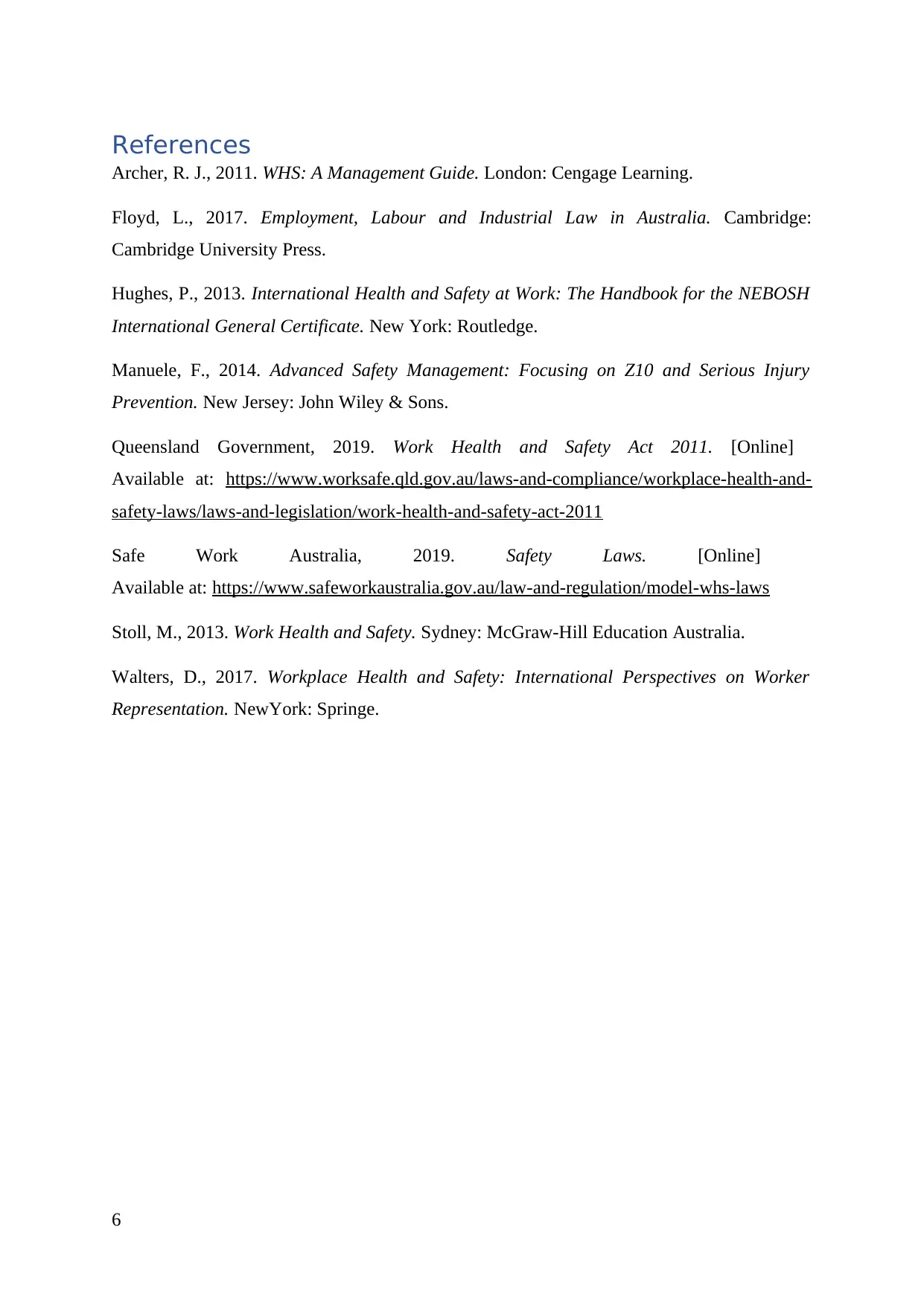
References
Archer, R. J., 2011. WHS: A Management Guide. London: Cengage Learning.
Floyd, L., 2017. Employment, Labour and Industrial Law in Australia. Cambridge:
Cambridge University Press.
Hughes, P., 2013. International Health and Safety at Work: The Handbook for the NEBOSH
International General Certificate. New York: Routledge.
Manuele, F., 2014. Advanced Safety Management: Focusing on Z10 and Serious Injury
Prevention. New Jersey: John Wiley & Sons.
Queensland Government, 2019. Work Health and Safety Act 2011. [Online]
Available at: https://www.worksafe.qld.gov.au/laws-and-compliance/workplace-health-and-
safety-laws/laws-and-legislation/work-health-and-safety-act-2011
Safe Work Australia, 2019. Safety Laws. [Online]
Available at: https://www.safeworkaustralia.gov.au/law-and-regulation/model-whs-laws
Stoll, M., 2013. Work Health and Safety. Sydney: McGraw-Hill Education Australia.
Walters, D., 2017. Workplace Health and Safety: International Perspectives on Worker
Representation. NewYork: Springe.
6
Archer, R. J., 2011. WHS: A Management Guide. London: Cengage Learning.
Floyd, L., 2017. Employment, Labour and Industrial Law in Australia. Cambridge:
Cambridge University Press.
Hughes, P., 2013. International Health and Safety at Work: The Handbook for the NEBOSH
International General Certificate. New York: Routledge.
Manuele, F., 2014. Advanced Safety Management: Focusing on Z10 and Serious Injury
Prevention. New Jersey: John Wiley & Sons.
Queensland Government, 2019. Work Health and Safety Act 2011. [Online]
Available at: https://www.worksafe.qld.gov.au/laws-and-compliance/workplace-health-and-
safety-laws/laws-and-legislation/work-health-and-safety-act-2011
Safe Work Australia, 2019. Safety Laws. [Online]
Available at: https://www.safeworkaustralia.gov.au/law-and-regulation/model-whs-laws
Stoll, M., 2013. Work Health and Safety. Sydney: McGraw-Hill Education Australia.
Walters, D., 2017. Workplace Health and Safety: International Perspectives on Worker
Representation. NewYork: Springe.
6
⊘ This is a preview!⊘
Do you want full access?
Subscribe today to unlock all pages.

Trusted by 1+ million students worldwide
1 out of 6
Related Documents
Your All-in-One AI-Powered Toolkit for Academic Success.
+13062052269
info@desklib.com
Available 24*7 on WhatsApp / Email
![[object Object]](/_next/static/media/star-bottom.7253800d.svg)
Unlock your academic potential
Copyright © 2020–2025 A2Z Services. All Rights Reserved. Developed and managed by ZUCOL.





